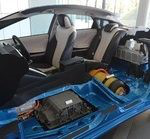
JAMA launches research to understand the combustion mechanism of carbon fibre
The Japan Automobile Manufacturers Association (JAMA) will start basic research on how to recycle CFRP (carbon fibre-reinforced plastics) used in fuel cell vehicles (FCV) from the second half of this year.
This research is intended to show the latest developments in recycling using existing combustion processing equipment and aims to understand the combustion mechanism of flame-retardant carbon fibre. Since CFRP are lightweight and have high-strength properties, their use is expected to increase in the future. JAMA believes that measures to prepare for future scrapped cars should be promoted right now, while the number of units sold is still small. Thus, the association decided to set up a research system.
Until now, JAMA demonstrated thermal recycling techniques in facilities such as those with electric furnaces, after processing of cutting and drilling scrap to enable reuse. These demonstrations show ways to recycle CFRP used in hydrogen storage tanks. Although there was a certain energy effect, the problem of the unburned carbon fibres remains.
In addition, the material can be recycled as part of a CFRP processing flow, but although JAMA has the technical skills, it is difficult to make the process economically viable. The association recognized that it is urgent to establish thermal recycling first, considering economic rationality.
With this in mind, the association decided to conduct research to understand the basic combustion characteristics of carbon fibre. Three priorities will be addressed in the second half of this year: 1) Organizing issues and setting combustion standards; 2) understanding the basic combustion characteristics of carbon fibre; and 3) understanding the combustion characteristics of alkali-silica mixed with CFRP. JAMA plans to start a CFRP combustion demonstration test in the second quarter of next year.
More information : www.jama-english.jp - Read the original article
--------------------------------------------------------------------------------------------------------------------------------------------------------------------------------------------------
Taisei Corporation: CFRP for lightweight architectural structures
Taisei Corporation developed a structural element based on carbon fibre-reinforced plastics (CFRP), the T-CFRP Beam (FR). The biggest point is the material’s workability that makes the element about one-fifth the weight of a steel frame. Using the light construction concept, the company aims to develop a renewal programme for buildings where construction using heavy components such as steel frames is difficult due to constraints including load conditions.
The newly developed T-CFRP Beam (FR) uses a CFRP material that is lightweight but has the same strength as traditional structural elements. This material is characterized by the ability to construct a free-form structural element with the required rigidity and strength using an easily shaped sheet-like CFRP prepreg in which the carbon fibre is impregnated with a fireproof epoxy resin.
Although the material cannot be welded, the span can be increased using one-side bolts used for joining steel frames. Its compliance with the Building Standards Act was secured by applying a unique fireproof coating, for example, by wrapping a fireproof coating material (aqua cover) around the CFRP element. While taking advantage of the material’s low weight, the element achieves both flexibility (corresponding to a large span) and fire resistance (applicable to fire-resistant construction) and can thus meet all needs.
Developing low-weight structural elements has been a challenge for the large-scale renovation and expansion of existing buildings, as well as construction work in locations where heavy machinery cannot be used. This new technology will respond to the increase in demand for building renewal.





 Lu public network security: 37140202000173
Lu public network security: 37140202000173



